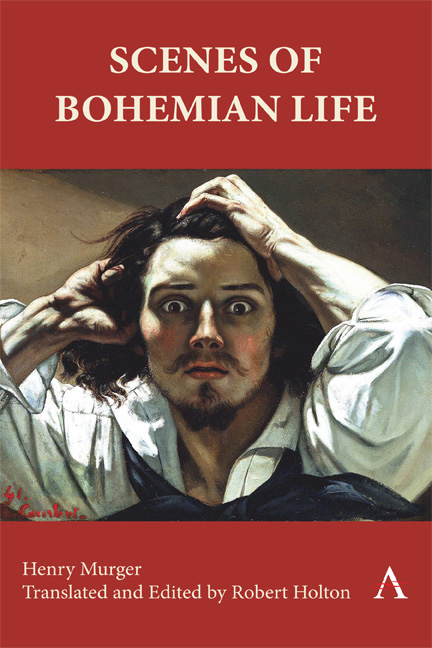Book contents
- Frontmatter
- Dedication
- Contents
- Introduction
- Chapter 1 How the Bohemian Society Was Established
- Chapter 2 A Gift from the Gods
- Chapter 3 Love at Lent
- Chapter 4 Ali-Rodolphe, or A Turk by Necessity
- Chapter 5 Charlemagne’s Coin
- Chapter 6 Mademoiselle Musette
- Chapter 7 The Sands of Pactolus
- Chapter 8 What Five Francs Can Cost
- Chapter 9 Polar Violets
- Chapter 10 The Cape of Storms
- Chapter 11 A Bohemian Café
- Chapter 12 A Reception in Bohemia
- Chapter 13 The Housewarming Party
- Chapter 14 Mademoiselle Mimi
- Chapter 15 Donec Gratus
- Chapter 16 The Passage of the Red Sea
- Chapter 17 The Graces Adorned
- Chapter 18 Francine’s Muff
- Chapter 19 Musette’s Whims
- Chapter 20 Mimi’s Fine Feathers
- Chapter 21 Romeo and Juliet
- Chapter 22 Epilogue to Love
- Chapter 23 Only Young Once
- Appendix: Murger’s Preface
- Notes
Chapter 16 - The Passage of the Red Sea
Published online by Cambridge University Press: 01 March 2024
- Frontmatter
- Dedication
- Contents
- Introduction
- Chapter 1 How the Bohemian Society Was Established
- Chapter 2 A Gift from the Gods
- Chapter 3 Love at Lent
- Chapter 4 Ali-Rodolphe, or A Turk by Necessity
- Chapter 5 Charlemagne’s Coin
- Chapter 6 Mademoiselle Musette
- Chapter 7 The Sands of Pactolus
- Chapter 8 What Five Francs Can Cost
- Chapter 9 Polar Violets
- Chapter 10 The Cape of Storms
- Chapter 11 A Bohemian Café
- Chapter 12 A Reception in Bohemia
- Chapter 13 The Housewarming Party
- Chapter 14 Mademoiselle Mimi
- Chapter 15 Donec Gratus
- Chapter 16 The Passage of the Red Sea
- Chapter 17 The Graces Adorned
- Chapter 18 Francine’s Muff
- Chapter 19 Musette’s Whims
- Chapter 20 Mimi’s Fine Feathers
- Chapter 21 Romeo and Juliet
- Chapter 22 Epilogue to Love
- Chapter 23 Only Young Once
- Appendix: Murger’s Preface
- Notes
Summary
For the past five or six years, Marcel had been working on his great painting, which he claimed was a representation of the biblical passage of the Red Sea. And for five or six years, this colorist masterpiece was stubbornly refused by the Salon's jury. It had been back and forth from the studio to the gallery and from the gallery to the studio so many times that if someone had put wheels under it, the painting could have found its way to the Louvre all on its own. Marcel, who had reworked the canvas ten times from top to bottom, insisted it was personal, that jury members’ hostility toward him had led to the annual ostracism keeping his work out of the exhibition hall. In honor of the Cerberuses of the Academy, in his spare time he compiled a small catalogue of insults complete with remarkably savage illustrations. The collection had become famous. In artists’ studios and the École des Beaux-Arts, it had achieved a level of success equal to the popularity of the immortal complaint of Giovanni Bellini, official painter for the Grand Sultan of Turkey. Every struggling painter in Paris had it committed to memory.
For a long time, Marcel was not discouraged by the harsh rejections he received from each exhibition. He was settled comfortably in the opinion that his painting was, though to a lesser degree, the long-awaited companion piece for Veronese's The Wedding at Cana, that enormous masterpiece whose overpowering brilliance was uncompromised by three centuries of dust neglect. And so every year at the time of the Salon, Marcel sent his painting to the jury for assessment. But in order to throw the jurors off track and thwart the obvious prejudice that led to the annual refusal of The Passage of the Red Sea, Marcel would alter certain details in the painting without altering the overall composition, and he’d give it a new title.
On one occasion it appeared in front of the jury with the title Crossing the Rubicon, but the Pharaoh, poorly disguised in Caesar's cloak, was recognized and turned away along with all the honors he was due.
- Type
- Chapter
- Information
- Scenes of Bohemian Life , pp. 135 - 140Publisher: Anthem PressPrint publication year: 2023

